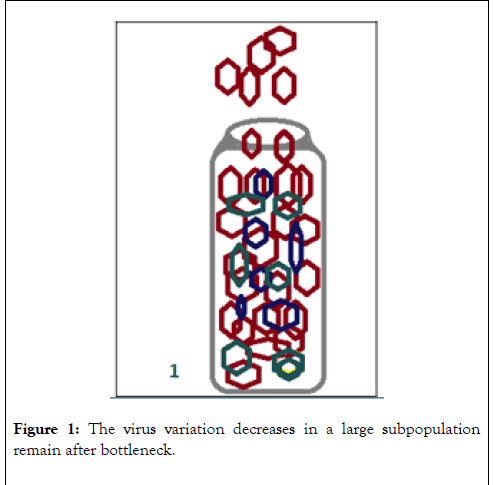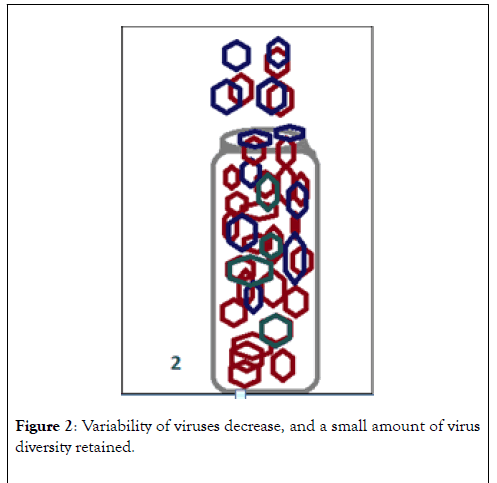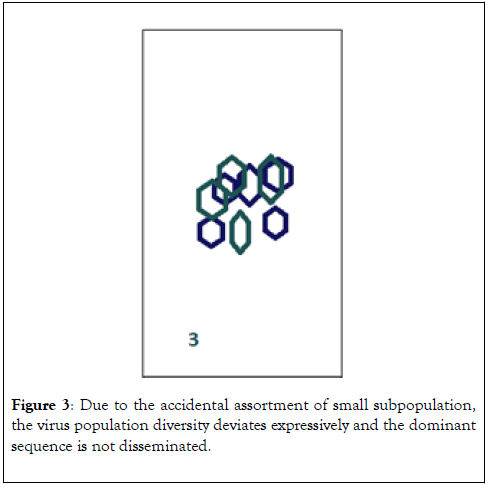Virology & Mycology
Open Access
ISSN: 2161-0517
ISSN: 2161-0517
Review - (2020)Volume 9, Issue 2
Arbovirus is an informal name used to refer to any viruses that are transmitted by arthropod vectors. They transmit viruses by biting a host. The vector enforces the virus to mutate. Evaluate the virus from mid gut to salivary gland, for the transmission of the virus to another host. This review is the recent one on arboviruses and on the method, which affect the arboviruses fitness and evolution. We emphasis the recent arboviruses research. West Nile virus and chikun gunya virus are used to compare the evolutionary pressure, mosquito bottlenecks and transmission of these viruses.
Arboviruses; Zoonotic viruses; Vector born viruses
Arboviruses are diverse group of zoonotic viruses, the spreading of these viruses occurs by hematophagous arthropod (ticks, mosquitoes, sand flies etc.) [1,2]. This virus infects the vector. It replicates and spread and eventually they come into the saliva of the infected vector. In vertebrate host viremia occurs if the host is infected by arbovirus. Many of the arbovirus starts infecting of the vector if they suck or ingest the blood in which the virus is already present. The infection starts from the epithelial cells. The virus then replicates, spread into the open body cavity, from there the virus can easily transmit and reach to any targeted organs, even salivary glands, by mechanical mean of transmission the mouth of the vector are contaminated with virus then feed on vertebrate host for infecting the host without replication in vector. The arbovirus vertically transmitted by means of eggs or through non-replicated viremia to vector which feed into a close proximity.
Arbovirus are ecologically extremely diverse, using vector in four diverse order of insect i.e. Hemiptera, Anoplura, Diptera and Siphonaptera and two family (Argasidae and lxodidae) of ticks as vector. Vertebrate host for arboviruses are mammals and birds.
Conferring evolutionary biology, the bottlenecks are the arbitrary event in which the number of the live replicating organisms are reduced to a smaller numeral, thus decrease the actual population number. In the bottleneck one of the two results will occur, either the extension of the population occurs or the population size will recover. The population genetic diversity will be decrease irrespectively of the result [3-5]. The following Figures 1-3 show the variations in diversity mostly linked with viruses.

Figure 1: The virus variation decreases in a large subpopulation remain after bottleneck.

Figure 2: Variability of viruses decrease, and a small amount of virus diversity retained.

Figure 3: Due to the accidental assortment of small subpopulation, the virus population diversity deviates expressively and the dominant sequence is not disseminated.
Humans, European rabbit, several viral populations and all other organism’s bottlenecks occur [6]. The absence of effective recombination of the genome of viral population bottlenecks ought in theory primes to steady extinction, which may be recover the original main sequence from the result of bottlenecks. Bottlenecks of viral population throughout life cycle rise the quantity of sub-optimally right viral particles being spread just by accidentally, conform the Muller`s Ratchet theory, which expects that asexual inhabitants of creatures that occasionally experience population bottlenecks must have a tendency to accrue harmful alterations if sex or recombination interevent to permit effective repair of the wild-type or principal sequence [7]. Bottleneck for the viruses can be experimentally brought by plaque to plaque transmission. Which pretend frequently natural bottlenecks occurrence. The fitness decrease as a result of mutation as the sequence of the virus remove from the typical order of viral population. In many viruses it has been verified experimentally [8]. Foot and mouth disease virus display bottlenecks occurrence persuaded mutable capability for almost 20 to 40 routes, through fitness viewing a static variation about the mean. Resulting the 20 to 40 ways the mean fitness reduced significantly but the fluctuation about the mean rise give increase to larger diversity in fitness. The fitness of plaque to plaque transmission does not decrease. There is no fitness increase when the virus is exposed to bottlenecks event up to 200, after the 20 to 40 ways, the reduction in mean fitness are noted. These viruses are than unable to recover from this reduced fitness and this show an irreversible and long-standing effect on viral population of the bottlenecks.
The bottlenecks effect on arbovirus is particularly significant as the (mosquito) vector subjects the virus to some structural bottlenecks [9]. The arbovirus infects all part of the mosquito, the infection starts from the midgut to spread into hemocoel, salivary glands for transmission. They are regularly exposed to bottlenecks as many of these cavities are divided by basal lamina with restricted viral dissemination. The early indication originates when ticks (mosquitoes) were infected with a particle similar to virus comprising replicons expressing reporters (such as green fluorescent protein). Which can allow to identify the quantity of cells which are primarily infected in the gut of mosquito. By using this method some cell was identified in the midgut of mosquito when they were infected with West Nile virus, Sindbis virus [10]. Showed the importance of bottleneck over the infection of midgut.
By bottlenecks the arboviral infection are affected. Further study on arboviruses are required to identify the pressure of evolution that impose on arbovirus by bottlenecks, the effect and severity of these viruses are just begin.
The virus uses different environment for their transmission cycle. The infection of the vertebrate host required to depend itself from the host immunity and to multiply up to highly sufficient titer to enable spread to the vector (arthropods). Within the host the virus is unable to replicate if their frequency is decreased [11]. On experimental base the infection of chikungunya virus, this virus is mutated for the reduction of mutant progeny by increasing the genome replication and to cause infection with less mortality. This result shows that most of the viruses develop an optimum level of replication diversity and fidelity. This virus infects the cell of mosquito without damaging it. Which remain in the mosquito for lifetime. The influence of the frequent bottlenecks gives a wide-ranging image of the complex interaction among the virus and mosquito that helps viral spread without antagonistic effects to the mosquito.
The arbovirus cycle among invertebrate and vertebrates, which used one or many host species which are closely related. They are replicated in two diverse host executes distinct selective limitations on arboviruses and figure their development. In both hosts invertebrate and vertebrate are considered to extant contradictory challenges that collectively limit the adaptation to any host alone by impressive fitness costs where variations are aggressive [12]. The arbovirus show less mutation than essential mutation rates. The experimental evolution studied with Chikungunya virus, VEEV etc.the host is removed by artificial means from changing transmission via sequential route, show the handle-offs integral to dual-host cycling. With some expectation these experiments suggest some ways of arboviral evolution. That is fitness lost in bypassed hosts and gained during serial passage. If no old host is involved the fitness will reduce in new host. The host are altered the fitness will increased. The fitness of arbovirus is strictly not limited to change invertebrate and vertebrate hosts.
The evolution and transmission of some arboviruses are mostly studied. For the first time in United States the west Nile virus are studied in detail, there evolution is studied in mosquito and avian host, this is the best flavivirus, how the host and virus interact. Recently chikungunya developed from enzootic cycle (in Africa) developed pandemic, causes millions of human infection cases in the previous few years. The recent epidemic of chikungunya virus, the cycle of transmission is well understood, so it is possible to study their detailed evolution. However, the more challenging are the less understand system.
This virus is more studied when it appears in United States, and its evolution are the topic of several paper, showed many changes genetically [13-16]. The host and vector stimulus the evolution of virus. To understand the effect on diversity and the diversity of the virus on host will raise the insight diversity on hosts.
The west Nile virus shows diversity in infected host. In experiment the virus is released by artificial mean from both of the host, the virus shows large diversity in chicken host as compared with chickens[17]. Upon infection of C. pipiens mosquito, they didn ’ t show any improvement of viral bottlenecks. Continues study is required to reach the comparative variations in progressive against structural decrease in variants in different systems.
Chikungunya virus belong to alphavirus, this virus is reemerging and expend to Europe, Indian islands, America from Africa, causes disease like febrile along with arthritis disease [18]. The chikungunya virus successively passaged in cell culture displayed advanced fitness in new cell categories and improved antiviral complex resistance, variations that were linked with improved genetic range [19-21]. When unique pressure is applied on virus the diversity will help the virus to mutate.
Subsequently, the creative work done by muller the population fitness and the severe effect of population bottlenecks gained a lot of experimental support, particularly by the use of virus for the model system because their population size is very large, rapidly mutated and experimentally tractable. In these studies, the arboviruses play an important role as mostly experience recombination irregularly. In laboratory studies the arbovirus is topic to fitness failures, resulting frequent bottlenecks. Further study is required.
Citation: Rehman T (2020) Arboviral Bottlenecks and Challenges to Maintaining Diversity and Fitness during Mosquito Transmission. Virol Mycol. 9:190. DOI: 10.35248/2161-0517.20.09.190.
Received: 03-Jul-2020 Accepted: 17-Jul-2020 Published: 24-Jul-2020 , DOI: 10.35248/2161-0517.20.09.190
Copyright: © 2020 Rehman T. This is an open-access article distributed under the terms of the Creative Commons Attribution License, which permits unrestricted use, distribution, and reproduction in any medium, provided the original author and source are credited.